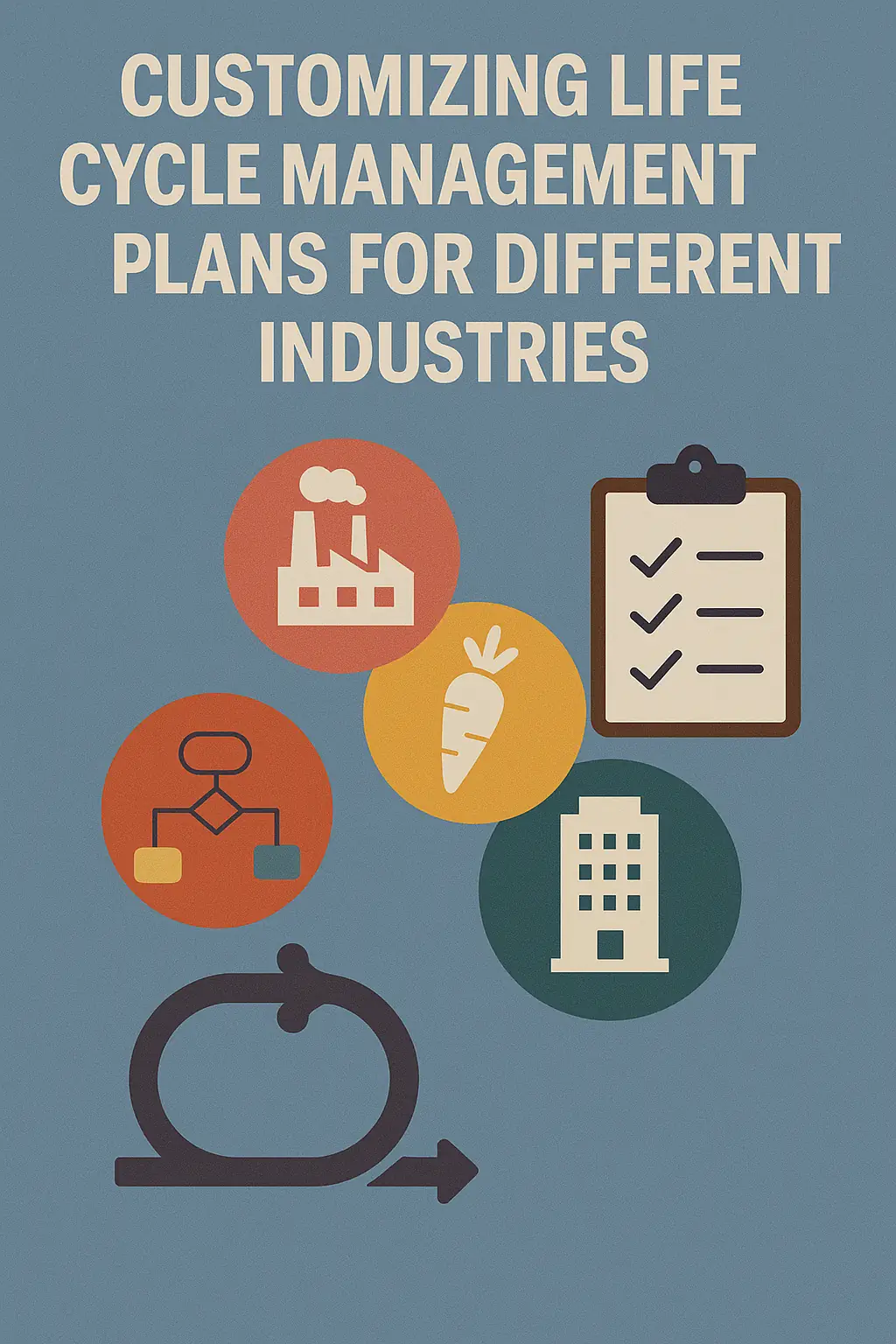Introduction to Life Cycle Management Plans
A Life Cycle Management Plan (LCMP) is a strategic framework that outlines the stages a project will undergo from inception to completion. This plan serves as a roadmap, guiding project managers through the various phases of a project, ensuring that all necessary steps are taken to achieve the desired outcomes.
Definition of Life Cycle Management Plans in Project Management
A Life Cycle Management Plan is defined as a comprehensive document that details the processes, methodologies, and tools that will be employed throughout the life cycle of a project. It encompasses all phases, including initiation, planning, execution, monitoring, and closure. The LCMP is crucial for establishing clear objectives, timelines, and resource allocations, which are essential for effective project execution.
Importance of Life Cycle Management in Ensuring Project Success
The significance of life cycle management in project management cannot be overstated. Here are some key reasons why it is vital for project success:
- Structured Approach: An LCMP provides a structured approach to managing projects, which helps in minimizing risks and uncertainties. By following a defined life cycle, project managers can anticipate challenges and devise strategies to address them proactively.
- Resource Optimization: Effective life cycle management ensures that resources are allocated efficiently throughout the project. This optimization leads to cost savings and better utilization of time and manpower.
- Stakeholder Engagement: A well-defined LCMP facilitates better communication and engagement with stakeholders. By outlining the project phases and expected outcomes, stakeholders can remain informed and involved, which enhances collaboration and support.
- Quality Assurance: Life cycle management includes quality control measures at each stage, ensuring that the project meets the required standards and delivers value to the organization.
Overview of How Life Cycle Management Varies Across Industries
Life cycle management is not a one-size-fits-all approach; it varies significantly across different industries due to unique operational requirements, regulatory environments, and stakeholder expectations. Here’s a brief overview of how LCMPs can differ:
- Construction: In the construction industry, life cycle management focuses heavily on compliance with safety regulations and environmental standards. The phases often include extensive planning and risk assessment to address potential hazards.
- Information Technology: For IT projects, life cycle management emphasizes agile methodologies and iterative processes. The focus is on rapid development and deployment, with continuous feedback loops to adapt to changing requirements.
- Healthcare: In healthcare, LCMPs must adhere to strict regulatory guidelines and focus on patient safety. The life cycle often includes phases for clinical trials, regulatory approvals, and post-market surveillance.
- Manufacturing: In manufacturing, life cycle management involves considerations for supply chain logistics, production efficiency, and product lifecycle sustainability. The phases may include design, production, distribution, and end-of-life management.
By understanding the foundational elements of life cycle management plans and recognizing how they can be tailored to meet the specific needs of various industries, project managers can enhance their strategic approach and drive project success across diverse sectors.
The Importance of Customization in Life Cycle Management
A Life Cycle Management Plan (LCMP) serves as a critical framework that guides projects from inception to completion. However, the effectiveness of an LCMP can vary significantly across different industries due to unique challenges and requirements. Customizing life cycle management strategies is not just beneficial; it is essential for ensuring project success. Here are several key points that underscore the importance of this customization.
Industry-Specific Challenges
- Regulatory Compliance: Different industries face varying levels of regulatory scrutiny. For instance, the healthcare sector must adhere to strict regulations regarding patient data and safety, while the construction industry must comply with local building codes and safety standards. A one-size-fits-all approach may overlook these critical compliance issues, leading to potential legal ramifications and project delays.
- Market Dynamics: Industries such as technology and finance are characterized by rapid changes and innovation cycles. A generic LCMP may not accommodate the fast-paced nature of these sectors, where project timelines can shift dramatically based on market demands. Customization allows project managers to incorporate agile methodologies that can adapt to these fluctuations.
- Resource Availability: Different industries have varying access to resources, including skilled labor, technology, and materials. For example, the manufacturing sector may face supply chain disruptions that require a tailored approach to resource management within the LCMP. Customizing the plan can help mitigate risks associated with resource scarcity and ensure project continuity.
Benefits of a Tailored Approach
- Improved Efficiency: Customizing life cycle management plans allows project managers to streamline processes that are specific to their industry. By focusing on relevant methodologies and tools, teams can reduce waste and enhance productivity. For instance, a software development project may benefit from integrating DevOps practices into its LCMP, leading to faster delivery times and higher quality outputs.
- Enhanced Stakeholder Satisfaction: Tailored LCMPs can better address the needs and expectations of stakeholders. By involving stakeholders in the customization process, project managers can ensure that their concerns are addressed, leading to increased buy-in and satisfaction. For example, in the construction industry, engaging local communities and regulatory bodies in the planning phase can foster goodwill and support for the project.
- Risk Mitigation: A customized LCMP can incorporate specific risk management strategies that are pertinent to the industry. For example, in the energy sector, where projects may involve significant environmental impacts, a tailored approach can include comprehensive environmental assessments and mitigation strategies, reducing the likelihood of costly delays or reputational damage.
Examples of Generic vs. Customized Life Cycle Management Plans
- Generic LCMP: A standard life cycle management plan might outline phases such as initiation, planning, execution, monitoring, and closure without considering the unique aspects of an industry. For instance, it may suggest a linear approach to project execution that does not account for the iterative nature of software development.
- Customized LCMP: In contrast, a customized LCMP for a software development project might include specific phases such as requirements gathering, iterative development sprints, user testing, and deployment, along with feedback loops that allow for continuous improvement. This tailored approach not only aligns with industry practices but also enhances the overall project outcome.
Industry-Specific Considerations for Life Cycle Management
A well-structured life cycle management plan is crucial for ensuring project success across various industries. However, the effectiveness of these plans can significantly vary based on industry-specific factors. Here, we explore key considerations that project managers must take into account when customizing life cycle management strategies to fit the unique needs of different sectors.
1. Regulatory Requirements Unique to Industries
Each industry operates under a distinct set of regulatory frameworks that can greatly influence life cycle management plans. For instance:
- Healthcare: This sector is heavily regulated, with strict compliance requirements such as HIPAA in the U.S. Project managers must ensure that life cycle management plans incorporate protocols for patient data protection, safety standards, and quality assurance processes. Failure to comply can lead to severe penalties and impact patient care.
- Finance: Financial institutions are subject to regulations like the Sarbanes-Oxley Act and Dodd-Frank Act, which mandate transparency and accountability. Life cycle management in this industry must include rigorous auditing processes and risk management strategies to safeguard against fraud and ensure compliance with financial reporting standards.
- Construction: The construction industry faces a myriad of regulations related to safety, environmental impact, and building codes. Project managers must tailor life cycle management plans to include compliance checks at various stages, ensuring that all safety measures are adhered to and that the project meets local zoning laws and environmental regulations.
2. Technological Advancements and Their Impact on Life Cycle Strategies
Technological innovations are reshaping how projects are managed across industries. The integration of new technologies can enhance efficiency, improve communication, and streamline processes. Key considerations include:
- Automation and AI: In industries like manufacturing and logistics, automation tools and AI can optimize project workflows, reduce human error, and enhance data analysis. Project managers should incorporate these technologies into their life cycle management plans to improve decision-making and resource allocation.
- Digital Collaboration Tools: The rise of remote work has led to the adoption of digital collaboration platforms across various sectors. Project managers must ensure that their life cycle management strategies leverage these tools to facilitate communication and collaboration among team members, regardless of their physical location.
- Data Analytics: The ability to analyze large datasets can provide insights into project performance and potential risks. Industries such as retail and marketing can benefit from incorporating data analytics into their life cycle management plans to make informed decisions and adapt strategies in real-time.
3. Cultural and Operational Differences That Shape Project Management Approaches
Cultural and operational factors play a significant role in shaping project management methodologies. Understanding these differences is essential for customizing life cycle management plans:
- Organizational Culture: Different industries have varying organizational cultures that influence project management styles. For example, the tech industry may favor agile methodologies that promote flexibility and rapid iteration, while the construction industry may adhere to more traditional, linear project management approaches. Project managers must align their life cycle management strategies with the prevailing culture to ensure buy-in and effective execution.
- Stakeholder Engagement: The level of stakeholder involvement can differ significantly across industries. In sectors like healthcare, where patient outcomes are paramount, engaging stakeholders throughout the project life cycle is critical. Conversely, in industries like software development, stakeholders may be more involved during the initial phases, with less engagement required during implementation. Tailoring life cycle management plans to accommodate these differences can enhance stakeholder satisfaction and project success.
- Resource Availability: The availability of resources, including skilled labor and technology, can vary widely between industries. Project managers must assess the specific resource landscape of their industry and adapt their life cycle management strategies accordingly, ensuring that they have the necessary tools and personnel to execute their plans effectively.
Customizing Life Cycle Management Plans for Key Industries
A life cycle management plan is essential for guiding projects from inception to completion. However, the effectiveness of these plans can vary significantly across different industries. Tailoring life cycle management strategies to meet the unique needs of each sector not only enhances project outcomes but also ensures compliance with industry standards and practices. Below are examples and strategies for customizing life cycle management plans for key industries.
1. Healthcare
In the healthcare industry, life cycle management plans must prioritize:
- Compliance with Regulations: Given the stringent regulations governing healthcare, project managers must ensure that all phases of the project adhere to legal and ethical standards. This includes understanding HIPAA regulations and other relevant laws.
- Patient Safety: Projects should be designed with patient safety as a core focus. This involves risk assessments and implementing safety protocols throughout the project life cycle.
- Technology Integration: As healthcare increasingly relies on technology, integrating new systems and ensuring interoperability with existing technologies is crucial. This requires a thorough understanding of both the technological landscape and the specific needs of healthcare providers.
2. Construction
For the construction industry, effective life cycle management plans should emphasize:
- Project Timelines: Construction projects are often time-sensitive. Developing a detailed timeline that accounts for all phases of construction, including design, permitting, and execution, is essential to avoid delays.
- Resource Management: Efficient allocation and management of resources, including labor, materials, and equipment, are critical. This involves careful planning and monitoring to ensure that resources are used effectively throughout the project.
- Risk Mitigation: The construction industry is fraught with risks, from safety hazards to budget overruns. Implementing a robust risk management strategy that identifies potential risks and outlines mitigation plans is vital for project success.
3. Information Technology
In the fast-paced world of information technology, life cycle management plans should focus on:
- Agile Methodologies: Embracing agile practices allows for flexibility and adaptability in project management. This approach encourages iterative development and continuous improvement, which is essential in a rapidly changing tech landscape.
- Rapid Iteration: Projects should be designed to allow for quick iterations based on user feedback. This ensures that the final product meets customer needs and expectations.
- Customer Feedback Loops: Incorporating mechanisms for gathering and analyzing customer feedback throughout the project life cycle helps in refining the product and enhancing user satisfaction.
4. Manufacturing
In the manufacturing sector, life cycle management plans should incorporate:
- Supply Chain Management: Effective management of the supply chain is crucial for ensuring that materials are available when needed. This involves coordinating with suppliers and optimizing inventory levels.
- Quality Control: Implementing stringent quality control measures throughout the production process helps in maintaining product standards and minimizing defects.
- Lean Practices: Adopting lean manufacturing principles can enhance efficiency by reducing waste and improving processes. This requires a thorough analysis of workflows and continuous improvement initiatives.
Developing a Customized Life Cycle Management Plan
Creating a tailored Life Cycle Management (LCM) plan is essential for project managers across various industries. A customized approach ensures that the unique needs and challenges of each sector are addressed effectively. Here’s a step-by-step guide to help project managers develop a customized LCM plan that aligns with their specific industry requirements.
Step-by-Step Process for Assessing Industry Needs
- Identify Industry Standards and Regulations: Research the specific standards and regulations that govern your industry. Understanding these requirements is crucial for compliance and can influence the LCM strategy.
- Conduct Stakeholder Analysis: Identify key stakeholders, including clients, team members, and regulatory bodies. Understanding their expectations and requirements will help shape the LCM plan.
- Analyze Current Processes: Evaluate existing life cycle processes within your organization. Identify strengths, weaknesses, and areas for improvement to inform the customization of your LCM plan.
- Gather Data and Insights: Collect quantitative and qualitative data relevant to your industry. This may include market trends, customer feedback, and performance metrics that can guide decision-making.
- Define Objectives and Goals: Establish clear objectives for the LCM plan that align with both organizational goals and industry-specific needs. This will provide a framework for measuring success.
Tools and Frameworks for Developing Customized Life Cycle Management Plans
- SWOT Analysis: Utilize SWOT (Strengths, Weaknesses, Opportunities, Threats) analysis to assess internal capabilities and external market conditions. This tool can help identify areas where customization is necessary.
- Project Management Software: Leverage project management tools like Microsoft Project, Asana, or Trello to create visual representations of the life cycle phases. These tools can facilitate collaboration and tracking throughout the project.
- Agile Methodologies: Consider adopting Agile frameworks, which allow for flexibility and iterative development. This approach can be particularly beneficial in industries that require rapid adaptation to change.
- Industry-Specific Frameworks: Research and apply frameworks that are tailored to your industry, such as ITIL for IT services or PMBOK for general project management. These frameworks provide best practices that can enhance your LCM plan.
Importance of Stakeholder Involvement and Feedback During the Customization Process
- Engagement and Buy-In: Involving stakeholders early in the customization process fosters engagement and buy-in. When stakeholders feel their input is valued, they are more likely to support the implementation of the LCM plan.
- Continuous Feedback Loop: Establish a feedback mechanism to gather insights from stakeholders throughout the project life cycle. Regular check-ins and surveys can help identify issues early and allow for timely adjustments to the plan.
- Collaboration and Communication: Promote open communication among all stakeholders. Collaborative discussions can lead to innovative solutions and ensure that the LCM plan remains aligned with industry needs.
- Adaptability: Stakeholder feedback can highlight changing industry dynamics or emerging trends. Being responsive to this feedback allows project managers to adapt their LCM plans accordingly, ensuring ongoing relevance and effectiveness.
By following these steps and utilizing the appropriate tools and frameworks, project managers can develop a customized Life Cycle Management plan that not only meets the specific needs of their industry but also enhances project success and stakeholder satisfaction.
Challenges in Customizing Life Cycle Management Plans
Customizing life cycle management plans to fit the specific needs of different industries can be a complex endeavor for project managers. While the benefits of tailored strategies are significant, several challenges can arise during the customization process. Below are some common obstacles and strategies to overcome them.
Common Challenges
- Resistance to Change: Employees and stakeholders may be accustomed to existing processes and hesitant to adopt new life cycle management strategies. This resistance can stem from fear of the unknown or a belief that current methods are sufficient.
- Lack of Resources: Customizing life cycle management plans often requires additional resources, including time, budget, and personnel. Many organizations may struggle to allocate these resources, especially in industries with tight margins or limited budgets.
- Inadequate Stakeholder Engagement: Successful customization relies heavily on the involvement of key stakeholders. A lack of engagement can lead to misalignment between the life cycle management plan and the actual needs of the organization.
- Insufficient Training: Project teams may not have the necessary skills or knowledge to implement customized life cycle management strategies effectively. This gap can hinder the successful execution of the plan.
Strategies for Overcoming Challenges
- Implementing Change Management Practices: To address resistance to change, project managers should employ change management techniques. This includes communicating the benefits of the new life cycle management plan clearly and involving team members in the customization process to foster a sense of ownership.
- Resource Allocation Planning: Conducting a thorough resource assessment can help identify gaps and prioritize resource allocation. Project managers can advocate for necessary resources by demonstrating the long-term benefits of customized life cycle management plans.
- Enhancing Stakeholder Engagement: Regularly engaging stakeholders through meetings, workshops, and feedback sessions can ensure that their needs and concerns are addressed. This engagement helps align the life cycle management plan with organizational goals and increases buy-in.
- Providing Comprehensive Training: Offering targeted training programs can equip project teams with the skills needed to implement customized strategies effectively. This training should be tailored to the specific challenges and requirements of the industry.
Conclusion
The significance of customizing life cycle management plans cannot be overstated. A tailored approach offers numerous benefits that enhance project outcomes across various industries. Here are some key takeaways:
- Enhanced Relevance and Effectiveness: By adapting life cycle management strategies to the specific needs of an industry, project managers can ensure that their plans are not only relevant but also effective. This customization allows for the incorporation of industry-specific regulations, standards, and best practices, leading to improved project performance and stakeholder satisfaction.
- Informed Decision-Making: A critical assessment of industry requirements enables project managers to make informed decisions that align with their organizational goals. Understanding the unique challenges and opportunities within their sector allows for the development of strategies that are both proactive and reactive, ultimately leading to better risk management and resource allocation.
- Fostering Innovation and Agility: Customizing life cycle management plans encourages a culture of innovation and agility. Project managers who continuously evaluate and adapt their strategies are better positioned to respond to changes in market conditions, technology advancements, and customer expectations. This adaptability not only enhances project success rates but also contributes to the overall growth and sustainability of the organization.
- Commitment to Continuous Improvement: The journey of life cycle management is ongoing. Project managers are encouraged to embrace a mindset of continuous improvement and learning. By regularly revisiting and refining their life cycle management strategies, they can stay ahead of industry trends and maintain a competitive edge.
In conclusion, the importance of customizing life cycle management plans lies in their ability to drive project success through relevance, informed decision-making, innovation, and a commitment to continuous improvement. Project managers across industries should take the initiative to critically assess their specific needs and adapt their strategies accordingly, ensuring that they are equipped to navigate the complexities of their respective fields effectively.
Find out more about Shaun Stoltz https://www.shaunstoltz.com/about/.
This post was written by an AI and reviewed/edited by a human.



